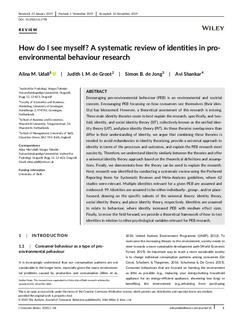| dc.description.abstract | Encouraging pro‐environmental behaviour (PEB) is an environmental and societal concern. Encouraging PEB focussing on how consumers see themselves (their identity) has blossomed. However, a theoretical assessment of this research is missing. Three main identity theories seem to best explain the research, specifically, and two‐fold, identity, and social identity theory (SIT), collectively known as the unified identity theory (UIT), and place identity theory (PIT). As these theories overlap more than differ in their understanding of identity, we argue that combining these theories is needed to avoid redundancies in identity theorizing, provide a universal approach to identity in terms of the processes and outcomes, and explain the PEB research most succinctly. Therefore, we understand identity similarly between the theories and offer a universal identity theory approach based on the theoretical definitions and assumptions. Finally, we demonstrate how the theory can be used to explain the research. Next, research was identified by conducting a systematic review using the Preferred Reporting Items for Systematic Reviews and Meta‐Analyses guidelines, where 62 studies were relevant. Multiple identities relevant for a given PEB are assumed and evidenced: 99. Identities are assumed to be either individually‐, group‐, and/or place‐focused, drawing on the specific subsets of the universal theory: identity theory, social identity theory, and place identity theory, respectively. Identities are assumed to relate to behaviour, where identity increased PEB with medium effect sizes. Finally, to move the field forward, we provide a theoretical framework of how to test identities in relation to other psychological variables relevant for PEB research. | nb_NO |

